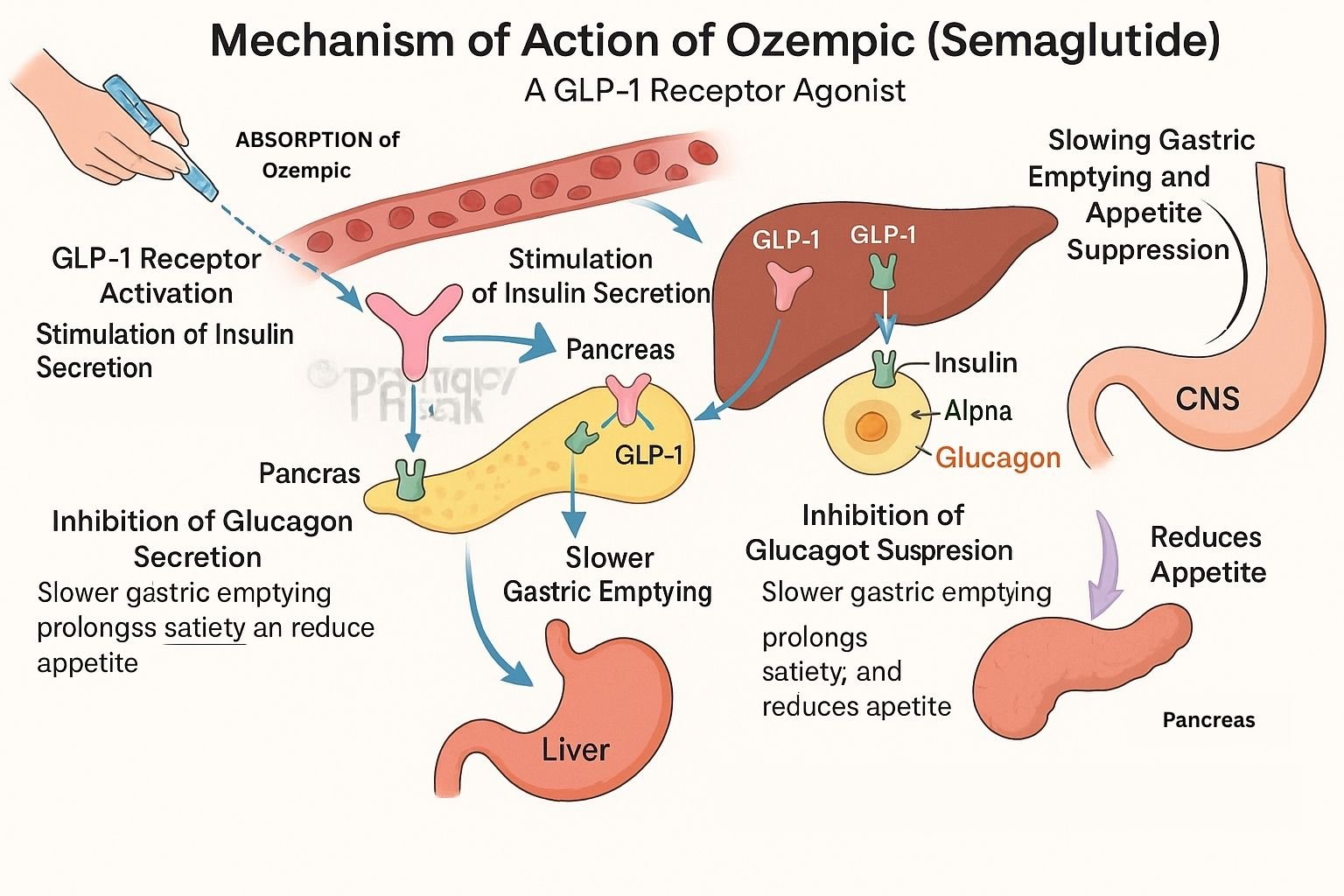Table of Contents
Introduction
Semaglutide (Ozempic for diabetes; Wegovy for obesity) is a GLP‑1 receptor agonist used for type 2 diabetes mellitus management and chronic weight loss. It mimics the incretin hormone glucagon‑like peptide‑1 (GLP‑1), leading to improved glycemic control, reduced appetite, delayed gastric emptying, and favorable effects on cardiovascular risk.
Step-by-Step Mechanism of Action
- GLP‑1 receptor activation
Semaglutide binds to GLP‑1 receptors on pancreatic β‑cells and brain centers, mimicking endogenous GLP‑1. - Glucose-dependent insulin secretion
Receptor activation increases cAMP in β‑cells, enhancing insulin release when blood glucose is elevated. - Glucagon suppression
It inhibits glucagon secretion from α‑cells, reducing hepatic glucose production. - Delayed gastric emptying
Acting on GLP‑1 receptors in the gut and brain delays gastric emptying, prolonging satiety and reducing postprandial glucose spikes. - Appetite reduction and weight loss
Central effects on the hypothalamus and brain stem decrease appetite and caloric intake, promoting weight loss. - Potential cardiovascular benefits
GLP‑1 receptor effects on endothelial and cardiac tissues may improve vascular health and reduce risk of major cardiovascular events.

Pharmacokinetic Parameters
| Parameter | Value |
|---|---|
| Route | Subcutaneous injection, weekly (Ozempic) or weekly/higher doses for Wegovy |
| Bioavailability | ~80–90% |
| Time to Peak (Tmax) | ~1–3 days |
| Half-life | ~7 days |
| Metabolism | Proteolytic degradation; no CYP involvement |
| Excretion | Urine (~3%), feces (~5%), remainder via metabolism |
Clinical Uses
- Primary treatment of type 2 diabetes mellitus to reduce HbA₁c
- Chronic weight management in obesity or overweight individuals with risk factors
- Reduces risk of major adverse cardiovascular events in high-risk diabetic patients
Adverse Effects
- Common: nausea, diarrhea, constipation, vomiting
- Less common: injection-site reactions, headache, dizziness
- Rare risk: pancreatitis; monitor for gallbladder disease
- Caution: use in patients with a history of medullary thyroid carcinoma or MEN2
Comparative Analysis
| Agent | Receptor Target | HbA₁c Reduction | Weight Loss | Administration Frequency |
|---|---|---|---|---|
| Semaglutide | GLP‑1 agonist | 1.5–2.3% | 10–17% | Weekly injection |
| Liraglutide | GLP‑1 agonist | ~1.0–1.5% | ~7–10% | Daily injection |
| Exenatide | GLP‑1 agonist | ~0.8–1.1% | ~3–5% | Twice daily or weekly |
MCQs (15)
- Semaglutide primarily acts on which receptor?
a) GIP receptor b) GLP‑1 receptor c) Insulin receptor d) DPP‑4 receptor
Answer: b) GLP‑1 receptor - It enhances insulin secretion in a _____ manner.
a) Glucose-dependent b) Constant c) Glucose-independent d) Time-dependent
Answer: a) Glucose-dependent - It suppresses which hormone?
a) Somatostatin b) Glucagon c) Ghrelin d) Cortisol
Answer: b) Glucagon - Typical onset of gastric emptying delay is:
a) Within minutes b) Within hours c) After weeks d) No effect
Answer: b) Within hours - Semaglutide injection frequency is:
a) Daily b) Weekly c) Monthly d) As-needed
Answer: b) Weekly - A rare but serious adverse effect to monitor is:
a) Hypoglycemia b) Pancreatitis c) Hyperthyroidism d) Nephrolithiasis
Answer: b) Pancreatitis - It is contraindicated in patients with:
a) Type 1 diabetes b) Medullary thyroid carcinoma c) Obesity d) Hypertension
Answer: b) Medullary thyroid carcinoma - Compared to exenatide, semaglutide yields:
a) Less weight loss b) More weight loss c) Higher injection frequency d) Less HbA₁c reduction
Answer: b) More weight loss - Half-life of semaglutide is approximately:
a) 24 hours b) 3 days c) 7 days d) 15 days
Answer: c) 7 days - Excretion involves:
a) High renal elimination b) Only feces c) Metabolism and minimal excretion d) Biliary excretion
Answer: c) Metabolism and minimal excretion - An added cardiovascular benefit was shown in:
a) SUSTAIN trials b) DPP‑4 studies c) RAAS inhibitor trials d) REM sleep studies
Answer: a) SUSTAIN trials - Weight loss percentage ranges from:
a) 1–5% b) 5–10% c) 10–17% d) 20–25%
Answer: c) 10–17% - A significant GI side effect is:
a) Increased appetite b) Nausea c) Insomnia d) Hypertension
Answer: b) Nausea - Semaglutide metabolism involves:
a) CYP3A4 b) Proteolysis c) Renal enzymes only d) Conjugation
Answer: b) Proteolysis - An advantage over liraglutide is:
a) Lower efficacy b) Higher weight loss c) Daily dosing d) Less frequent injection
Answer: d) Less frequent injection
FAQs
- Does semaglutide cause weight loss in non-diabetic patients?
Yes—it’s approved for chronic weight management under Wegovy, showing 10–17% loss. - How soon does glycemic control improve?
HbA₁c reduction is often seen within 4–8 weeks. - Can semaglutide be combined with insulin?
Yes—with adjustment; monitor for hypoglycemia. - Is cardiovascular benefit proven?
Yes—major trials showed reductions in cardiovascular events in diabetic patients. - Does semaglutide need dose titration?
Yes—gradual dose escalation helps improve tolerance, especially GI.
References
- Goodman & Gilman’s The Pharmacological Basis of Therapeutics, 13th Edition
- KD Tripathi. Essentials of Medical Pharmacology, 8th Edition
- DrugBank: Semaglutide pharmacology summary
- StatPearls: Semaglutide in diabetes and obesity
- PubMed: SUSTAIN trials glycemic and cardiovascular outcomes
- PubMed: Wegovy weight loss evidence

I am pursuing MBA in pharmaceutical management from NIPER Hyderabad with a strong academic record and proven success in national-level pharmacy entrance exams. I secured AIR 61 in NIPER 2024 (MS/M.Pharm) and AIR 27 in NIPER MBA, along with AIR 147 in GPAT 2024 and AIR 907 in GPAT 2023. I also achieved AIR 6 in AIIMS CRE-2025 for Drug Store Keeper and was selected as a Pharmacist (AIR 61) for ESIC. Additionally, I was the Runner-Up in Round 2 of the EY Case Study Competition.
At PharmacyFreak.com, I aim to guide future pharmacists through expert content, exam strategies, and insightful resources based on real experience and academic excellence.
Mail- harsh@pharmacyfreak.com

